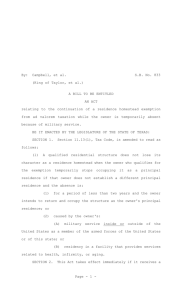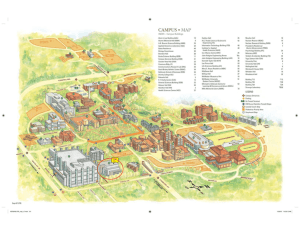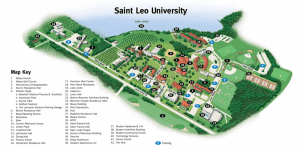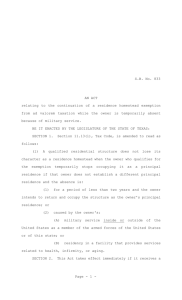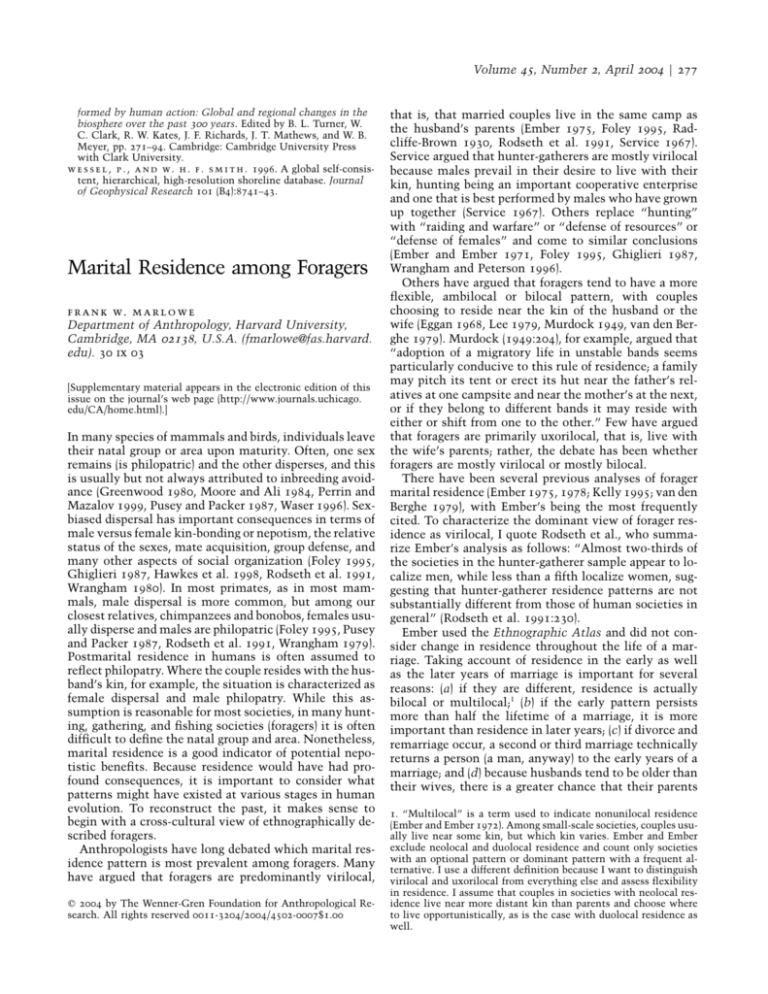
Volume 45, Number 2, April 2004 F 277
formed by human action: Global and regional changes in the
biosphere over the past 300 years. Edited by B. L. Turner, W.
C. Clark, R. W. Kates, J. F. Richards, J. T. Mathews, and W. B.
Meyer, pp. 271–94. Cambridge: Cambridge University Press
with Clark University.
w e s s e l , p . , a n d w. h . f . s m i t h . 1996. A global self-consistent, hierarchical, high-resolution shoreline database. Journal
of Geophysical Research 101 (B4):8741–43.
Marital Residence among Foragers
f r a n k w. m a r l o w e
Department of Anthropology, Harvard University,
Cambridge, MA 02138, U.S.A. (fmarlowe@fas.harvard.
edu). 30 ix 03
[Supplementary material appears in the electronic edition of this
issue on the journal’s web page (http://www.journals.uchicago.
edu/CA/home.html).]
In many species of mammals and birds, individuals leave
their natal group or area upon maturity. Often, one sex
remains (is philopatric) and the other disperses, and this
is usually but not always attributed to inbreeding avoidance (Greenwood 1980, Moore and Ali 1984, Perrin and
Mazalov 1999, Pusey and Packer 1987, Waser 1996). Sexbiased dispersal has important consequences in terms of
male versus female kin-bonding or nepotism, the relative
status of the sexes, mate acquisition, group defense, and
many other aspects of social organization (Foley 1995,
Ghiglieri 1987, Hawkes et al. 1998, Rodseth et al. 1991,
Wrangham 1980). In most primates, as in most mammals, male dispersal is more common, but among our
closest relatives, chimpanzees and bonobos, females usually disperse and males are philopatric (Foley 1995, Pusey
and Packer 1987, Rodseth et al. 1991, Wrangham 1979).
Postmarital residence in humans is often assumed to
reflect philopatry. Where the couple resides with the husband’s kin, for example, the situation is characterized as
female dispersal and male philopatry. While this assumption is reasonable for most societies, in many hunting, gathering, and fishing societies (foragers) it is often
difficult to define the natal group and area. Nonetheless,
marital residence is a good indicator of potential nepotistic benefits. Because residence would have had profound consequences, it is important to consider what
patterns might have existed at various stages in human
evolution. To reconstruct the past, it makes sense to
begin with a cross-cultural view of ethnographically described foragers.
Anthropologists have long debated which marital residence pattern is most prevalent among foragers. Many
have argued that foragers are predominantly virilocal,
䉷 2004 by The Wenner-Gren Foundation for Anthropological Research. All rights reserved 0011-3204/2004/4502-0007$1.00
that is, that married couples live in the same camp as
the husband’s parents (Ember 1975, Foley 1995, Radcliffe-Brown 1930, Rodseth et al. 1991, Service 1967).
Service argued that hunter-gatherers are mostly virilocal
because males prevail in their desire to live with their
kin, hunting being an important cooperative enterprise
and one that is best performed by males who have grown
up together (Service 1967). Others replace “hunting”
with “raiding and warfare” or “defense of resources” or
“defense of females” and come to similar conclusions
(Ember and Ember 1971, Foley 1995, Ghiglieri 1987,
Wrangham and Peterson 1996).
Others have argued that foragers tend to have a more
flexible, ambilocal or bilocal pattern, with couples
choosing to reside near the kin of the husband or the
wife (Eggan 1968, Lee 1979, Murdock 1949, van den Berghe 1979). Murdock (1949:204), for example, argued that
“adoption of a migratory life in unstable bands seems
particularly conducive to this rule of residence; a family
may pitch its tent or erect its hut near the father’s relatives at one campsite and near the mother’s at the next,
or if they belong to different bands it may reside with
either or shift from one to the other.” Few have argued
that foragers are primarily uxorilocal, that is, live with
the wife’s parents; rather, the debate has been whether
foragers are mostly virilocal or mostly bilocal.
There have been several previous analyses of forager
marital residence (Ember 1975, 1978; Kelly 1995; van den
Berghe 1979), with Ember’s being the most frequently
cited. To characterize the dominant view of forager residence as virilocal, I quote Rodseth et al., who summarize Ember’s analysis as follows: “Almost two-thirds of
the societies in the hunter-gatherer sample appear to localize men, while less than a fifth localize women, suggesting that hunter-gatherer residence patterns are not
substantially different from those of human societies in
general” (Rodseth et al. 1991:230).
Ember used the Ethnographic Atlas and did not consider change in residence throughout the life of a marriage. Taking account of residence in the early as well
as the later years of marriage is important for several
reasons: (a) if they are different, residence is actually
bilocal or multilocal;1 (b) if the early pattern persists
more than half the lifetime of a marriage, it is more
important than residence in later years; (c) if divorce and
remarriage occur, a second or third marriage technically
returns a person (a man, anyway) to the early years of a
marriage; and (d) because husbands tend to be older than
their wives, there is a greater chance that their parents
1. “Multilocal” is a term used to indicate nonunilocal residence
(Ember and Ember 1972). Among small-scale societies, couples usually live near some kin, but which kin varies. Ember and Ember
exclude neolocal and duolocal residence and count only societies
with an optional pattern or dominant pattern with a frequent alternative. I use a different definition because I want to distinguish
virilocal and uxorilocal from everything else and assess flexibility
in residence. I assume that couples in societies with neolocal residence live near more distant kin than parents and choose where
to live opportunistically, as is the case with duolocal residence as
well.
278 F c u r r e n t a n t h ro p o l o g y
will be dead, especially as the marriage continues. This
last point means that even if virilocal residence is said
to be the rule, in practice we may find it less common
than expected simply because of demographics. My goal
here is to improve on previous analyses by considering
additional variables from the less biased Standard CrossCultural Sample. The results of my analysis refute the
dominant view of forager residence as virilocal.
materials and methods
To analyze residence patterns I used the World Cultures
CD (2001), which contains all the variables coded in the
Ethnographic Atlas (EA), and the Standard Cross-Cultural Sample (SCCS).The EA includes information culled
from the ethnographies of 1,267 societies, but only a few
variables have been coded, and there is no attempt to
control for sample bias. The SCCS, however, includes
186 societies with good ethnographic coverage that have
been chosen to create an unbiased sample of the world’s
societies with respect to geographic region, language
family, and cultural area, and many variables have been
coded.
I defined “foragers” as those with ! 10% direct dependence on agriculture, ! 10% direct dependence on animal
husbandry, trade accounting for less than 50% of the diet
and less than any single source, and no horse-mounted
hunters. All other societies were considered nonforagers.
[The codes for all variables used are explained in the
appendix in the electronic edition of the issue on the
journal’s web page.]
The SCCS has several marital residence variables.
“Marital residence with kin: after first years” (v215) is
the one most often cited,2 but there is another on residence in the first years of marriage (v213). Two other
variables on the World Cultures CD (v214 and v216) are
the same as 213 and 215 respectively but recoded as
“Transfer of residence at marriage: first years” and “after
first years” by collapsing categories as follows: 1 p wife
to husband’s group; 2 p couple to either group or neolocal; 3 p husband to wife’s group; 4 p no common
residence;3 5 p for v214, same as v216.
I used the transfer variables as they are coded on the
World Cultures CD because they are simpler, better get
at the issue of which sex is localized with kin, and avoid
the problems of definitions that specify living with parents one or both of whom may be dead. For convenience,
I call #1 “virilocal” and #3 “uxorilocal” (even though
these terms normally refer specifically to living with parents while “patrilocal” refers to living with husband’s
father and “matrilocal” to living with wife’s mother as
in unilineal kin groups, which often do not exist among
foragers).
To take account of residence in both early and later
years for all the societies in the SCCS, I computed a new
variable called “residence” to distinguish societies in
which transfer in the first years (v214) and transfer in
the later years (v216) were different or the same. The
residence variable distinguishes societies that have a
prevalent unilocal form (to wife’s or to husband’s group
in both early and later years) from those with a prevalent
multilocal form (to either group, to both groups, or to
neither group), and it is coded as follows: 1pvirilocal,
wife to husband’s group early/later (v216 p 1, v214 p
5,1)(female dispersal); 2 p multilocal, ambi-/neolocal or
first one and then the other (( 1,3 )(bisexual dispersal);
3 p uxorilocal, husband to wife’s group early/later (v216
p 3, v214 p 5,3)(male dispersal).
In some species of cercopithecine primates dispersal
is extremely sex-biased, with none of the females emigrating, while in East African chimpanzees none of the
males emigrate (Pusey and Packer 1987). If this sort of
philopatry existed among human foragers, there would
be no frequent alternative to the prevalent form of residence but only one sex dispersing. I therefore computed
another variable by recoding residence as “strict residence” using the presence or absence of a frequent alternative form (v218). Strict virilocality, for example, occurs when residence is with husband’s group in early and
later years and there is no alternative form. Strict residence is coded as follows: 1 p virilocal, early/later, no
alternative (residence p 1, v218 p 4,1)(only females disperse); 2 p multilocal (( 1,3)(both sexes disperse); 3 p
uxorilocal, early/later, no alternative (residence p 3,
v218 p 4,3)(only males disperse).
Nonparametric Mann-Whitney U tests were used for
all comparisons between foragers and nonforagers. All
correlations reported are Spearman ranked correlations.
results
2. Murdock’s codes in the EA from which the SCCS residence variables are taken are as follows: A, avunculocal; B, ambilocal; C,
optionally uxorilocal or avunculocal; D, optionally patrilocal (or
virilocal) or avunculocal; M, matrilocal; N, neolocal; O, nonestablishment of a common household; P, patrilocal; U, uxorilocal; V,
virilocal. This is all that Murdock says about how he coded residence. Lower-case letters following a capital indicate either culturally patterned alternatives to or numerically significant deviations from the prevailing profile. Lower-case letters preceding a
capital indicate the existence of a different rule or profile for the
first years of marriage (e.g., uP indicates initial uxorilocal residence
followed by permanent patrilocal residence).
3. No common residence is reported for only four societies, only
one in later years, and none among foragers and is therefore lumped
with #2 in residence and strict residence.
There are 36 foraging societies in the SCCS by my criteria (table 1).4 The results of statistical tests are reported
in table 2. Residence among foragers is significantly dif-
4. North America is overrepresented among foragers (83% in the
EA, 50% in the SCCS) because there were many foragers there when
ethnographies were first written, while the Circum-Mediterranean
region is completely absent because foragers had disappeared there
before ethnographies were written. This regional skew cannot be
corrected and might still be a problem using phylogenetic comparative methods.
Volume 45, Number 2, April 2004 F 279
table 1
Foragers in the Standard Cross-Cultural Sample
SCCS
No.
2
9
13
77
79
80
86
90
91
118
119
120
122
123
124
125
126
127
128
129
130
131
132
133
134
135
136
137
138
139
162
173
178
179
180
186
Name
Kung∗
Hadza∗
Mbuti∗
Semang∗
Andaman∗
Vedda∗
Badjau∗
Tiwi∗
Aranda∗
Ainu
Gilyak
Yukaghir
Ingalik
Aleut
C. Eskimo
Montagnais
Micmac
Saulteaux
Slave
Kaska
Eyak
Haida
Bellacoola
Twana∗
Yurok
Pomo∗
Yokuts∗
Paiute
Klamath
Kutenai
Warrau∗
Siriono∗
Botocudo∗
Shavante∗
Aweikoma∗
Yahgan
Regiona
(v200)
A
A
A
EE
EE
EE
IP
IP
IP
EE
EE
EE
NA
NA
NA
NA
NA
NA
NA
NA
NA
NA
NA
NA
NA
NA
NA
NA
NA
NA
SA
SA
SA
SA
SA
SA
ET
%
Gathering
(v205)
%
Hunting
(v204)
%
Fishing
(v203)
% Male
Contribution
(100%–v885)
16.7
20.9
19.5
17.1
23.6
22.7
25.1
22.7
16.0
12.3
10.8
9.6
10.4
10.4
8.8
11.8
12.5
11.4
10.7
10.7
10.9
11.3
11.8
13.0
12.9
14.2
14.9
12.7
11.6
12.3
14.8
19.3
18.0
21.3
14.4
9.5
80
60
30
40
40
40
00
50
60
20
20
10
10
10
00
20
10
20
10
10
20
20
20
10
40
40
50
50
30
30
40
30
50
40
40
10
20
40
70
30
20
30
0
30
40
30
30
50
40
30
40
60
50
40
50
40
30
20
20
30
10
30
20
30
20
30
30
50
40
30
60
20
0
0
0
30
40
30
80
20
0
40
50
40
50
60
60
20
40
40
40
50
50
60
60
60
50
30
30
20
50
40
20
10
10
10
0
70
40
40
52
80
50
80
65
40
40
52
80
100
77
90
85
70
92
70
80
65
80
80
80
75
57
62
79
50
57
70
72
80
50
62
70
55
Descentb
(v70)
Marriagec
Model/
Alternate
(v208/9)
Transfer:
After
First Years
(v216)
Transfer:
First
Years
(v214)
B
B
B
B
B
M
B
D
D
D
P
B
B
P
B
B
B
P
B
M
M
M
A
B
B
B
P
B
B
B
B
B
B
P
B
B
BS
BP
FKE/BP
A
A
TBP
BP
BP/BS
Dowry
A
BP
BS/FKE
A
BS
BS
BS
BS
A
BS
BS
BS
BS
GE
GE/BP
BP
A
A
A
GE/BP
A
BS
A
A
BS
A
BS/TBP
Ambi/NeoAmbi/NeoHusband’s
Husband’s
Ambi/NeoWife’s
Ambi/NeoHusband’s
Husband’s
Husband’s
Husband’s
Wife’s
Wife’s
Husband’s
Ambi/NeoHusband’s
Husband’s
Husband’s
Husband’s
Wife’s
Husband’s
Husband’s
Husband’s
Husband’s
Husband’s
Ambi/NeoHusband’s
Wife’s
Husband’s
Husband’s
Wife’s
Wife’s
–
Wife’s
Ambi/NeoHusband’s
Wife’s
Same
Same
Wife’s
Same
Same
Same
Same
Same
Same
Same
Wife’s
Same
Wife’s
Same
Same
Wife’s
Same
Wife’s
Same
Wife’s
Wife’s
Same
Same
Same
Same
Wife’s
Wife’s
Same
Wife’s
Same
Same
–
Same
Same
Same
Transfer:
Alternate
Form
(v218)
Residence
Strict
Residence
Same
Same
Wife’s
Same
Same
Ambi-NeoSame
Wife’s
Same
Wife’s
Same
Husband’s
Husband’s
Same
Husband’s
Same
Same
Wife’s
Wife’s
Same
Same
Same
Wife’s
Same
Wife’s
Same
Same
Husband’s
Wife’s
Wife’s
Same
Same
–
Same
Same
Same
Multilocal
Multilocal
Virilocal
Multilocal
Multilocal
Uxorilocal
Multilocal
Virilocal
Virilocal
Virilocal
Virilocal
Multilocal
Uxorilocal
Multilocal
Multilocal
Virilocal
Multilocal
Virilocal
Multilocal
Uxorilocal
Multilocal
Multilocal
Virilocal
Virilocal
Virilocal
Multilocal
Multilocal
Multilocal
Virilocal
Multilocal
Uxorilocal
Uxorilocal
–
Uxorilocal
Multilocal
Virilocal
Multilocal
Multilocal
Multilocal
Multilocal
Multilocal
Multilocal
Multilocal
Multilocal
Virilocal
Multilocal
Virilocal
Multilocal
Multilocal
Multilocal
Multilocal
Virilocal
Multilocal
Multilocal
Multilocal
Uxorilocal
Multilocal
Multilocal
Multilocal
Virilocal
Multilocal
Multilocal
Multilocal
Multilocal
Multilocal
Multilocal
Uxorilocal
Uxorilocal
–
Uxorilocal
Multilocal
Virilocal
a
A, Africa; EE, East Eurasia; IP, Insular Pacific; NA, North America; SA, South America.
B, bilateral; M, matrilineal; P, patrilineal; D, double; A, ambilineal.
BS, bride service; BP, bride price; FKE, female kin exchange; A, absence of consideration; GE, gift exchange; TBP, token bride price; D, dowry.
∗Warm-climate sample, n p 16 since Botocudo residence data are missing.
b
c
ferent from residence among nonforagers.5 Compared
with nonforagers, foragers are significantly less virilocal
(U p 1,950, p p .006, n p 185) and more multilocal (U
p 2,165, p p .039, n p 185) (fig. 1). This is mainly
because early residence among foragers is significantly
biased toward uxorilocality (U p 2,085, p p .019, n p
185) and less toward virilocality (U p 1,932, p p .005,
n p 185) (fig. 2). One reason for this is bride service (in
which a man provides food to his wife’s family and therefore usually resides with them), which is more common
among foragers (36%) than among nonforagers (7%) (U p
1,923, p ! .0005, n p 186). Bride price is more common
among nonforagers (44%) than among foragers (14%) (U
p 1,887, p p .001, n p 186), since wealth can be used to
purchase wives. Table 2 shows that strict residence is also
significantly less virilocal among foragers than among
nonforagers (U p 2,055, p p .013, n p 185) and that a
higher percentage (74%) of foragers is multilocal (U p
2,127.5, p p .041, n p 185).
Many of the foraging societies in this sample are arctic
5. Even using the EA and the variable Ember (1978) used (v11, v215
in the SCCS but the transfer version coded virilocal or not), foragers
are less virilocal than nonforagers (U p 105,514, p p .001, n p
1,267).
and subarctic foragers. If we are interested in residence
patterns prior to the fairly recent occupation of such cold
climates, we need a sample of foragers in warmer climates. Effective temperature is a variable that reflects
the intensity and distribution of solar radiation, calculated from the mean temperature of the warmest and
coldest months. If we limit the sample to societies for
which effective temperature is ≥13⬚ C (noted by ∗ in table
1), about the latitude of the U.S.-Canada border, we get
a sample that is not only more relevant for earlier times,
prior to the appearance of agriculture, but also geographically balanced. This warm-climate sample has 19% of
the societies in each region (Africa, East Eurasia, Insular
Pacific, North America) except South America, with
25%. It displays no bias toward virilocal residence at all,
with multilocality being dominant (table 2, fig. 3). With
strict residence, there is an even greater dominance of
multilocality (69%) and a slight bias toward uxorilocality
(18.8%) over virilocality (12.5%) (fig. 4).
Foragers also differ from nonforagers in reckoning kinship. A higher percentage of foraging societies (64%) than
of nonforaging societies (31%) trace their kin through
both mother and father (bilateral descent) (U p 1,803, p
! .0005, n p 186). Nonforagers are more patrilineal (47%)
280 F c u r r e n t a n t h ro p o l o g y
than foragers (14%) (U p 1,815, p ! .0005, n p 186).
Across all societies, patrilineal societies are more likely
to have virilocal residence (U p 2,693, p ! .0005, n p
185). Thus, descent and residence appear to influence
each other, as we would expect, since kin ties are going
to be stronger when people live together. The much more
frequent nonunilineal descent (bilateral, double, ambilineal) of foragers (75%) suggests that they are interacting
bilaterally even when residence is unilocal.
Foragers are less virilocal and more multilocal than
nonforagers because of the distribution of the foods they
acquire and the way they go about acquiring them. Even
among many of the societies classified here as nonforagers there is some degree of gathering, hunting, and
fishing, and this helps illuminate their effects. Across all
societies, the greater the dependence on gathering, hunting, and fishing, the less likely that residence is virilocal.
Hunting has the strongest effect and, contrary to the
argument of Service (1967), results in less, not more,
virilocality (rs p ⫺.220, p p .003, n p 185).
Hunting is also correlated with bilateral descent and
less sedentism, probably because mobile resources such
as game require large home ranges. This illustrates how
other factors that explain residence flow from the food
quest. For example, foragers are less sedentary than nonforagers (U p 826, p ! .0005, n p 186). Most foragers in
the SCCS sample are coded as nomadic or seminomadic
(72% and 88% in the warm-climate sample) while only
15% of nonforagers (mostly pastoralists and some horticulturalists) are so coded. Across all societies, those
that are more sedentary are more likely to have virilocal
residence (rs p .249, p p .001, n p 185) and less likely
to have multilocal residence. Across all societies, greater
dependence on hunting and gathering (but not fishing)
is associated with less sedentism. Foragers that are more
sedentary are more likely to have unilineal descent (rs p
.331, p p .049, n p 36), live at higher latitudes (rs p
.461, p p .005, n p 36), and do more fishing (rs p .453,
p p .006, n p 36). Hunting and gathering (but not fishing)
Fig. 1. Percentage of nonforagers (gray bars) and foragers (black bars) by residence, based on early and
later years of marriage (n p 185).
favor greater mobility, which is associated with flexible
residence and bilateral descent.
Because of the constraints of foraging, a third reason
foragers are less virilocal and more multilocal than nonforagers is their significantly smaller local groups (median population ! 50), which require that people find
mates outside their camp. Among nonforagers, many societies can afford to be unilocal and marry within their
own local group, since sex-ratio variation and perhaps
inbreeding are less of a problem in larger groups (Ember
and Ember 1972). Across all societies, there is a higher
percentage of endogamous marriage where strict residence is unilocal (rs p .153, p p .039, n p 185) and
where local groups are larger (rs p .206, p p .012, n p
table 2
Marital Residence Patterns (Percentage) of Nonforagers, Foragers, and Warm-Climate Foragers
Sample and Category
Early Transfer
Late Transfer
Residence
Strict Residence
60.7∗∗
11.3
28∗
70.7
14.7
14.7
60∗∗
25.3∗
14.7
30.7∗
60.7∗
8.7
34.3∗∗
17.1
48.6∗
57.1
20
22.9
34.3∗∗
42.9∗
22.9
14.3
74.3∗
11.4
25
31.3
43.8
37.5
37.5
25
25
50
25
12.5
68.8
18.8
Nonforagers (n p 150)
Virilocal
Multilocal
Uxorilocal
Foragers (n p 35)
Virilocal
Multilocal
Uxorilocal
Warm-climate foragers (n p 6)
Virilocal
Multilocal
Uxorilocal
note: Botocudo residence data are missing.
∗p ! .05.
∗∗p ! .01.
Volume 45, Number 2, April 2004 F 281
Fig. 2. Percentage of nonforagers (gray bars) and foragers (black bars) by transfer of residence during the
first years of marriage (n p 185).
148). Foragers live in such small groups that they need
to find mates outside their local group even when
unilocal. Even though some foragers accomplish this
through large seasonal aggregations, multilocal residence
may often be favored because those willing and able to
reside in either their own or their spouse’s camp maximize their marital options.
Another reason that foragers are less virilocal than
nonforagers is that, owing to the constraints of foraging,
they have little wealth. For example, foragers are significantly more likely to have no inheritance of land
(72.2%; warm-climate foragers 88.2%) than nonforagers
(22%) (U p 826.5, p ! .0005, n p 157). They are also
more likely to have no inheritance of movable property
(U p 1,346, p p .002, n p 152). With agriculture and
sedentism, land can be guarded and resources stored.
When resources can be controlled, it pays males more
than females to accumulate large amounts of them, since
they can convert them into much greater reproductive
success (for example, bride price to acquire many wives).
Parents will gain more by passing resources to sons than
to daughters, and this will favor virilocality and patrilineal descent (Clutton-Brock, Albon, and Guinness
1981, Hartung 1982, Trivers and Willard 1973, Willson
and Pianka 1963). Across all societies, for example, there
is a correlation between virilocal residence and patrilineal inheritance of land (rs p .389, p ! .0005, n p 154)
and movable property (rs p .340, p ! .0005, n p 152).
With little wealth, foragers do not gain as much from
male-biased inheritance and thus have less reason to reside virilocally.
Yet another reason that foragers are less virilocal than
nonforagers is that they have a lower frequency of warfare, probably because they have less stored wealth and
less defensible home ranges. Warfare could favor virilocal
residence, since related males should be better able to
defend the group (Ember and Ember 1971, Rodseth et al.
1991). There are two kinds of warfare in the SCCS, warfare between local groups in one ethnic community and
warfare between different ethnic communities. What is
true across all societies is also true across foragers; internal warfare is correlated with virilocal residence (rs p
.421, p p .020, n p 30) but external warfare is not (rs p
⫺.004, p p .983, n p 31). Internal warfare is rare among
foragers (median p 1: absent or rare), and both types of
warfare are significantly less frequent among foragers
than among nonforagers. Since most foragers have peaceful interactions with other camps within their ethnic
group, there is less need for defense and virilocality is
less common than it is among nonforagers. With the
advent of agriculture and the increasing importance of
property, warfare probably contributed to the increase in
virilocality.
Some have suggested that virilocality might be favored
where men contribute more to subsistence and uxorilocality where women contribute more (Linton 1936,
Murdock 1949, Service 1967). Across all societies, there
is no correlation between male contribution to subsistence and residence (but see Korotayev 2001). Among
foragers there is an almost significant relationship,
though it is opposite of the one predicted. Males contribute less where residence is virilocal and more where
it is uxorilocal. This may be due to the interaction between residence and polygyny, especially sororal polygyny, since the proportion of polygynous men is greater
where women contribute more to subsistence (Marlowe
2003).
discussion
Contrary to the conclusion of Rodseth et al. (1991) that
“hunter-gatherer residence patterns are not substantially
Fig. 3. Residence among warm-climate foragers (n p
16), showing number and percentage of societies in
each category.
282 F c u r r e n t a n t h ro p o l o g y
posed to adopt when around his mother-in-law.6 If residence were strictly virilocal, there would be little opportunity for a man to be around his mother-in-law
because he and his wife should be living with his kin,
not his wife’s kin. Citing Nicholas Peterson, Hiatt (1996:
152) says,
It was normal in many tribes for a man upon marrying to take up residence in the band of his wife’s father. Given the contractual obligation of a son-inlaw, it was obviously convenient to have him near
at hand. At the same time, proximity increased the
risk of sexual entanglement. . . . To put people’s
minds at rest, especially no doubt that of his wife’s
father, the son-in-law signaled day-in and day-out
through his ritualized and overstated avoidance behaviour that there was no cause for worry: “I am
here to give my mother-in-law gifts of meat, nothing
else.”
Fig. 4. Strict residence among warm-climate foragers
(n p 16), showing number and percentage of societies
in each category.
different from those of human societies in general,” there
is a significant difference between them. Many foragers
also have a frequent alternative to the prevalent mode
of residence, which means that they have greater residential flexibility than nonforagers. Among the Hadza,
with whom I work, couples live with the wife’s parents,
the husband’s parents, parents of both at the same time,
or no parents but more distant kin such as aunts or siblings. Sometimes they are in small camps with no kin.
The only appropriate term for this is multilocal. A similar pattern is reported for many other foragers (Kelly
1995).
Because of the fluidity of forager residence, it is easiest
to describe residence with respect to which spouse’s parents (or other close kin) live in the same camp, but what
often happens is that elderly people decide which of their
children they should go to live with rather than the other
way around (as, for example, among the Hadza and the
Ju/’hoansi [Irv DeVore, personal communication]). The
elderly parents may be indifferent as to whether they
live in the same camp as their sons or daughters. If their
choice depends on which grandchildren they want to
help rather than which children can help them, we might
expect them to prefer to live with daughters, since paternity uncertainty means that they can be more certain
of their genetic relatedness to their grandchildren
through their daughters than through their sons. Alternatively, if they live with their sons, they may be able
to increase their sons’ paternity confidence by monitoring their daughters-in-law.
Many societies classified as virilocal, such as many
Australians, were in reality probably less so. Among several Australian societies there was a style of speaking,
called “mother-in-law language,” that a man was sup-
Because of the obligations men had to their in-laws,
women as well as men maintained ties to their kin.
Virilocality may be overestimated even in the data presented here, since residence in later years is often a stated
ideal rather than an observed frequency. Many Hadza I
interviewed said that it was best to live with the wife’s
kin in the early years and with the husband’s kin later
on, but a synchronic census revealed that 68% of monogamously married women whose mothers were living
resided in the same camp with them (Woodburn 1968).
As was pointed out long ago in a debate on residence
(Fischer 1958; Goodenough 1956, 1962), ethnographers
in the past often attended more to stated rules than to
the frequency of actual observed behavior. Many of the
codes in the EA are derived from brief ethnographic descriptions based on interviews with one or a few informants (Alvarez 2004). For this reason, strict residence may
be a more reliable measure of sex bias in dispersal than
residence. After all, it is difficult to imagine how an ethnographer could err in describing a society as uxorilocal
in early years and in later years and in having no frequent
alternative form if in reality there were an overall bias
toward virilocality. As table 2 shows, there is no sex bias
in dispersal using strict residence.
Dispersal can be broken into social (from group) and
locational (from area) (Isbell, Cheney, and Seyfarth 1990,
Waser 1996), but even this distinction is inadequate to
handle the complexities among many human foragers.
Among the Hadza, for example, by the time a child is
weaned he or she will have lived in several different
camps in different areas with a wide range of people—
some related through the mother, some through the father, and some not related at all. Parents, if they are alive
and not divorced, may be the only ones who have remained throughout. How can we decide whether it is
the wife or the husband who leaves the natal group or
area upon marrying? Should “natal” refer to the first
month of life, the first year, or the whole time prior to
6. Because a man was usually much older than his wife, his motherin-law might be his age or younger.
Volume 45, Number 2, April 2004 F 283
marriage? With the emergence of agriculture, residence
usually becomes less fluid and natal group and area less
difficult to ascertain. Male philopatry tends to be favored
among nonforagers because a sedentary existence promotes territorial defense and control of resources. Once
wealth exists, male inheritance makes sense, and when
land is inherited virilocal residence should become much
more likely. Even though pastoralists are very nomadic,
they can defend their resources (livestock) and therefore
have good reason to be patrilineal and virilocal.
Explaining why foragers are less virilocal than nonforagers is easier than explaining why human foragers
are more multilocal than most primates, including our
closest relatives, chimpanzees and bonobos. The hominin diet is probably the key. Foragers, especially those
who hunt and gather rather than fish, acquire foods that
are spatially dispersed, such as tubers, honey, game, fruit,
and berries. Foraging for these foods requires large day
ranges. Depletion and seasonal fluctuation in foods require that camps move every so often, and therefore
home ranges are much larger than those of our closest
relatives. In short, the forager diet favors mobility. By
maintaining kin ties traced bilaterally, individuals can
increase their residential options. This allows them to
move to available resources, but it also allows them to
move away from someone they do not like or to move
to a camp with potential mates. Bilateral descent facilitates multilocal residence. Without long-term pair
bonds one could not know who one’s father was and
kinship could not be reckoned bilaterally. Therefore, diet
alone may not be enough to explain multilocality, which
may have evolved in conjunction with pair bonds and
kin classification.
In conclusion, contrary to the orthodox view, most
foragers are not virilocal. Women frequently live with
their kin, especially in the early years of marriage. Murdock’s bilocal view is supported by the cross-cultural
data and for just the reasons he cited: small, mobile,
flexible groups that maintain ties with kin of both husband and wife are well suited to foraging for dispersed
and seasonal foods.
References Cited
a l v a r e z , h . 2004. “Residence groups among hunter-gatherers:
A view of the claims and evidence for patrilocal bands,” in
Kinship and behavior in Primates. Edited by B. Chapais and C.
M. Berman. New York: Oxford University Press. In press.
c l u t t o n - b ro c k , t . h . , s . d . a l b o n , a n d f . e .
g u i n n e s s . 1981. Parental investment in male and female
offspring in polygynous mammals. Nature 289:487–89.
e g g a n , f . 1968. Comments on “Typology and reconstruction,”
in Man the hunter. Edited by R. B. Lee and I. DeVore, pp.
161–62. Chicago: Aldine.
e m b e r , c . r . 1975. Residential variation among hunter-gatherers. Behavior Science Research 10:199–227.
———. 1978. Myths about hunter-gatherers. Ethnology 17:
439–48.
e m b e r , c . r . , a n d m . e m b e r . 1972. The conditions favoring multilocal residence. Southwestern Journal of Anthropology 28:382–400.
e m b e r , m . , a n d c . r . e m b e r . 1971. The conditions favor-
ing matrilocal versus patrilocal residence. American Anthropologist 73:571–94.
f i s c h e r , j . l . 1958. The classification of residence in censuses. American Anthropologist 60:508–17.
f o l e y, r . 1995. The adaptive legacy of human evolution: A
search for the environment of evolutionary adaptedness. Evolutionary Anthropology 4:194–203.
g h i g l i e r i , m . 1987. Sociobiology of the great apes and the
hominid ancestor. Journal of Human Evolution 16:319–58.
g o o d e n o u g h , w. h . 1956. Residence rules. Southwestern
Journal of Anthropology 12:22–37.
———. 1962. Kindred and hamlet in Lakalai, New Britain. Ethnology 1:5–12.
g r e e n w o o d , p . j . 1980. Mating systems, philopatry, and dispersal in birds and mammals. Animal Behaviour 28:1140–62.
h a r t u n g , j . 1982. Polygyny and inheritance of wealth. current anthropology 23:1–12.
hawkes, k., j. o’connell, n. g. blurton jones,
h . a l v a r e z , a n d e . l . c h a r n o v. 1998. Grandmothering, menopause, and the evolution of human life histories. Proceedings of the National Academy of Sciences, U.S.A. 95:
1336–39.
h i a t t , l . r . 1996. Arguments about Aborigines. Cambridge:
Cambridge University Press.
i s b e l l , l . a . , d . l . c h e n e y, a n d r . m . s e y f a r t h .
1990. Costs and benefits of home range shifts among vervet
monkeys (Cercopithecus aethiops) in Amboseli National Park,
Kenya. Behavioral Ecology and Sociobiology 27:351–58.
k e l l y, r . l . 1995. The foraging spectrum. Washington, D.C.:
Smithsonian Institution Press.
k o r o t a y e v, a . 2001. An apologia of George Peter Murdock:
Division of labor by gender and postmarital residence in crosscultural perspective, a reconsideration. World Cultures 12:
179–203.
l e e , r . b . 1979. The !Kung San: Men, women, and work in a
foraging society. Cambridge: Cambridge University Press.
l i n t o n , r . 1936. The study of man. New York: AppletonCentury.
m a r l o w e , f . w. 2003. The mating system of foragers in the
Standard Cross-Cultural Sample. Cross-Cultural Research 37:
282–306.
m o o r e , j . , a n d r . a l i . 1984. Are dispersal and inbreeding
avoidance related? Animal Behaviour 32:94–112.
m u r d o c k , g . p . 1949. Social structure. New York:
Macmillan.
p e r r i n , n . , a n d v. m a z a l o u . 1999. Dispersal and inbreeding avoidance. American Naturalist 154:282–92.
p u s e y, a . e . , a n d c . p a c k e r . 1987. “Dispersal and philopatry,” in Primate societies. Edited by B. Smuts, D. L. Cheney,
R. M. Seyfarth, R. W. Wrangham, and T. T. Struhsaker, pp.
250–66. Chicago: University of Chicago Press.
r a d c l i f f e - b r o w n , a . r . 1930. The social organization of
Australian tribes. Oceania 1:34–63.
r o d s e t h , l . , r . w. w r a n g h a m , a . m . h a r r i g a n ,
a n d b . s m u t s . 1991. The human community as a primate
society. current anthropology 12:221–54.
s e r v i c e , e . r . 1967. Primitive social organization. New York:
Random House.
t r i v e r s , r . l . , a n d d . e . w i l l a r d . 1973. Natural selection of parental ability to vary the sex ratio of offspring. Science 179:90–92.
v a n d e n b e r g h e , p . 1979. Human family systems. Prospect
Heights: Waveland.
w a s e r , p . m . 1996. “Patterns and consequences of dispersal in
gregarious carnivores,” in Carnivore behavior, ecology, and
evolution, vol. 2. Edited by J. L. Gittleman, pp. 267–95. Ithaca:
Cornell University Press.
w i l l s o n , m . f . , a n d e . f . p i a n k a . 1963. Sexual selection, sex ratio, and mating system. American Naturalist 97:
405–7.
w o o d b u r n , j . 1968. “Stability and flexibility in Hadza residential groupings,” in Man the hunter. Edited by R. B. Lee and
I. DeVore, pp. 103–10. Chicago: Aldine.
284 F c u r r e n t a n t h ro p o l o g y
World Cultures. 2001. Journal of Comparative and Cross-Cultural Research 12(1).
w r a n g h a m , r . w. 1979. On the evolution of ape social systems. Social Science Information 18:335–68.
———. 1980. An ecological model of female-bonded primate
groups. Behaviour 75:262–300.
w r a n g h a m , r . w. , a n d d . p e t e r s o n . 1996. Demonic
males. Boston: Houghton Mifflin.
The Problem with Boys:
Bridewealth Accumulation, Sibling
Gender, and the Propensity to
Participate in Cattle Raiding
among the Kuria of Tanzania
m i c h a e l l . f l e i s h e r and
garth j. holloway
Ethiopian Landmine Impact Survey, P.O. Box 26407,
Code 1000, Addis Ababa, Ethiopia (m.fleisher@juno.
com)/Department of Agriculture and Food Economics,
School of Agriculture, Policy, and Development,
University of Reading, P.O. Box 237, Reading RG6
6AR, U.K. (garth.holloway@reading.ac.uk). 30 xi 03
[Supplementary material appears in the electronic edition of this
issue on the journal’s web page (http://www.journals.uchicago.
edu/CA/home.html).]
Although a fair amount has been written on the subject
of African “crime” in general (e.g., Read 1964, Brillon
1985, Austen 1986, Cohen 1986, Crummey 1986) and
East African livestock theft in particular (e.g., Fukui and
Turton 1979, Anderson 1986, Hendrickson, Mearns, and
Armon 1996), scant effort has been made to establish
who, in a sociological sense, these “criminals” are (but
see Moore 1975 and Heald 1986 for two noteworthy exceptions). This article endeavors to contribute to this
effort using field data collected among the agro-pastoral
Kuria of Tarime District in northern Tanzania.
Among the Kuria, whose population straddles the border between Tanzania and Kenya, many young men are
actively engaged in an illict livestock trade in which cattle
stolen in Tanzania—mainly from other Kuria but also
from neighboring peoples—are sold to buyers, mainly
butchers, inside Tanzania or else run across the border for
cash sale in Kenya. Kuria cattle raiding is by no means a
new phenomenon, but it has undergone a profound transformation in the course of the past century—from its precolonial roles of demonstrating the mettle of new warriors
and enlarging the community cattle herd to an illicit, of䉷 2004 by The Wenner-Gren Foundation for Anthropological Research. All rights reserved0011-3204/2004/4502-0008$1.00
ten quite violent cash-market-oriented enterprise—in response to the pressures exerted by the colonial economy,
capitalist penetration, and the policies of the postcolonial
Tanzanian state (Fleisher 2000a, b).
Fleisher (1999) has already demonstrated that, among
the Kuria, cattle theft is overwhelmingly the “occupation” of choice of those young Kuria men whom he has
termed “sister-poor,” that is, those whose natal households lack a sufficient number of daughters to bring a
large enough number of bridewealth cattle into the
household to enable all of the sons of that household to
acquire their first wives. Kuria bridewealth has historically been among the highest in East Africa, and it remains so to this day—notwithstanding the drastic decline, owing to cattle raiding and other factors, that the
Kuria cattle herd has suffered in the course of the past
30 years. With income-generating opportunities in the
area scarce, education levels low, and cattle the most
prevalent highly valued commodity, a young Kuria man
has scant, if any, alternatives to raiding for acquiring his
bridewealth cattle if his family has an insufficient number of cattle at home.
In this report we draw on our analysis of data collected
in a random survey of homesteads in Nyaheiya (not its
real name), a Kuria village of the Nyamongo clan located
in the Tarime District lowlands of northern Tanzania,
about 90 kilometers from Tarime town, as a means of
illuminating the characteristics of homesteads likely to
include cattle raiders among their residents.
the ethnographic setting
The field research on which this report is based was carried out in Nyaheiya over a 19-month period from August 1994 to March 1996. Although the village’s proximity to the Mara River ensures it year-round water and
plentiful, nutritious pastureland for its herd of about
5,800 cattle, agriculture is precarious there because of
erratic rainfall patterns and recurrent drought. In the face
of sporadically inadequate harvests, villagers are compelled to buy a substantial portion of their food from
farmers in neighboring Serengeti District, relying on cattle raiding and on gold prospecting in the indigenous lowtechnology mining areas that pockmark the Nyamongo
area to fulfill their cash needs.
Nyaheiya occupies an area of roughly 110 square kilometers and has an estimated population of 2,232 residing in 350 homesteads, each presided over by a male
homestead head. A typical homestead consists of the
male head, his wife or wives and all their unmarried
children, and all their married sons, their wives, and their
children. The widowed mother of the homestead head
and sometimes other guests and relatives may also make
their home there. Once a son of the homestead head has
had his eldest child—of whichever sex—circumcised,
this son, his wife or wives, and their children typically
move out of the homestead to establish a new homestead
of their own.
A homestead is, in turn, made up of one or more
mother-centered households, each consisting of a wife


